This shrimp stir fry is ready in about 30 minutes. It's the ultimate weeknight dinner - quick, easy to make, and delicious.
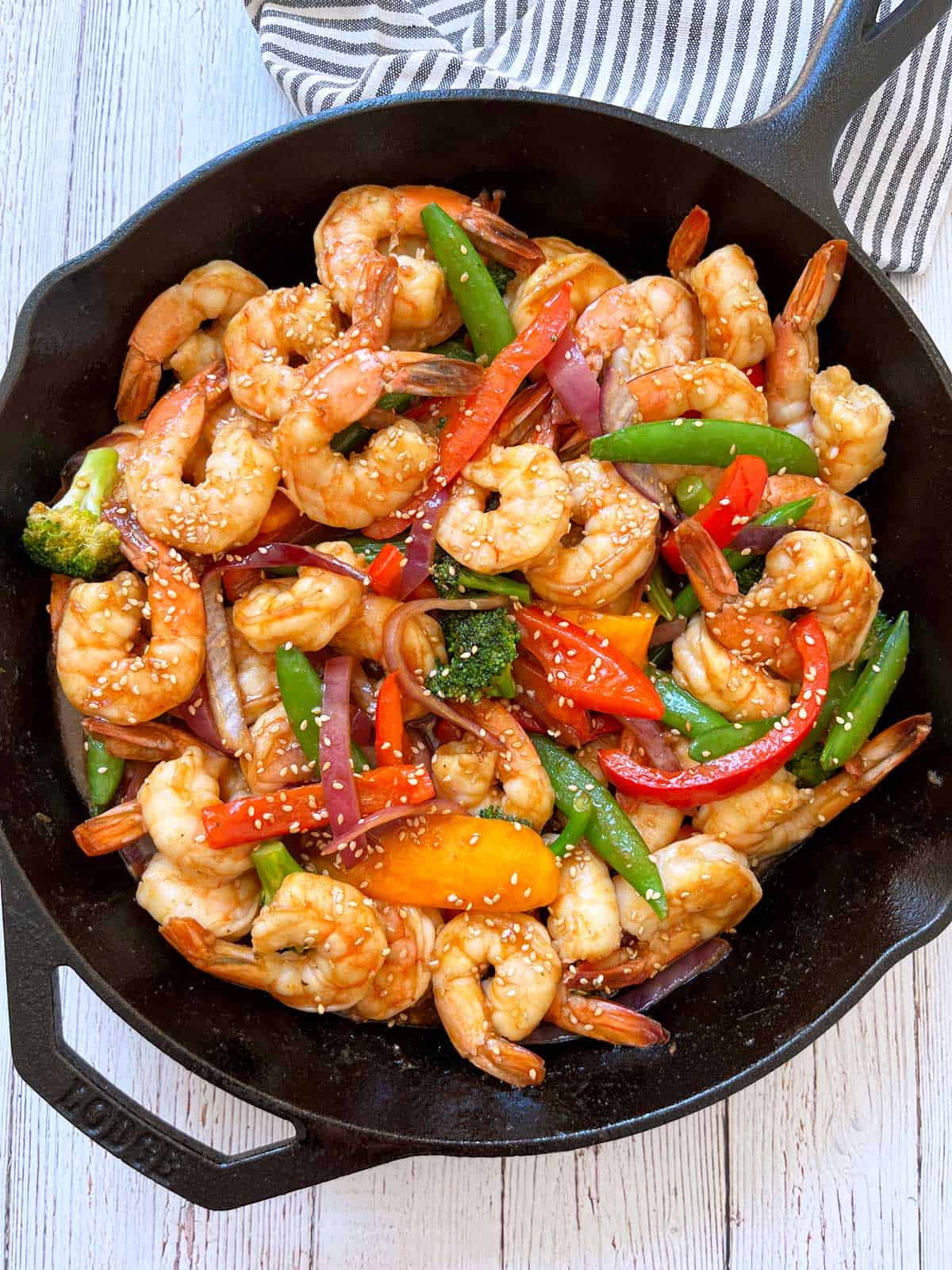
I love making shrimp recipes like grilled shrimp. I also enjoy stir fry recipes like pork stir fry. When combining these two into a shrimp stir fry, what's not to like? It's one of the recipes I make regularly for my family. It's ready fast, the sauce is wonderfully flavorful, and you can use any sturdy veggies you have on hand.
Ingredients
In the sauce, I use reduced sodium soy sauce, water, honey, sriracha, and cornstarch.
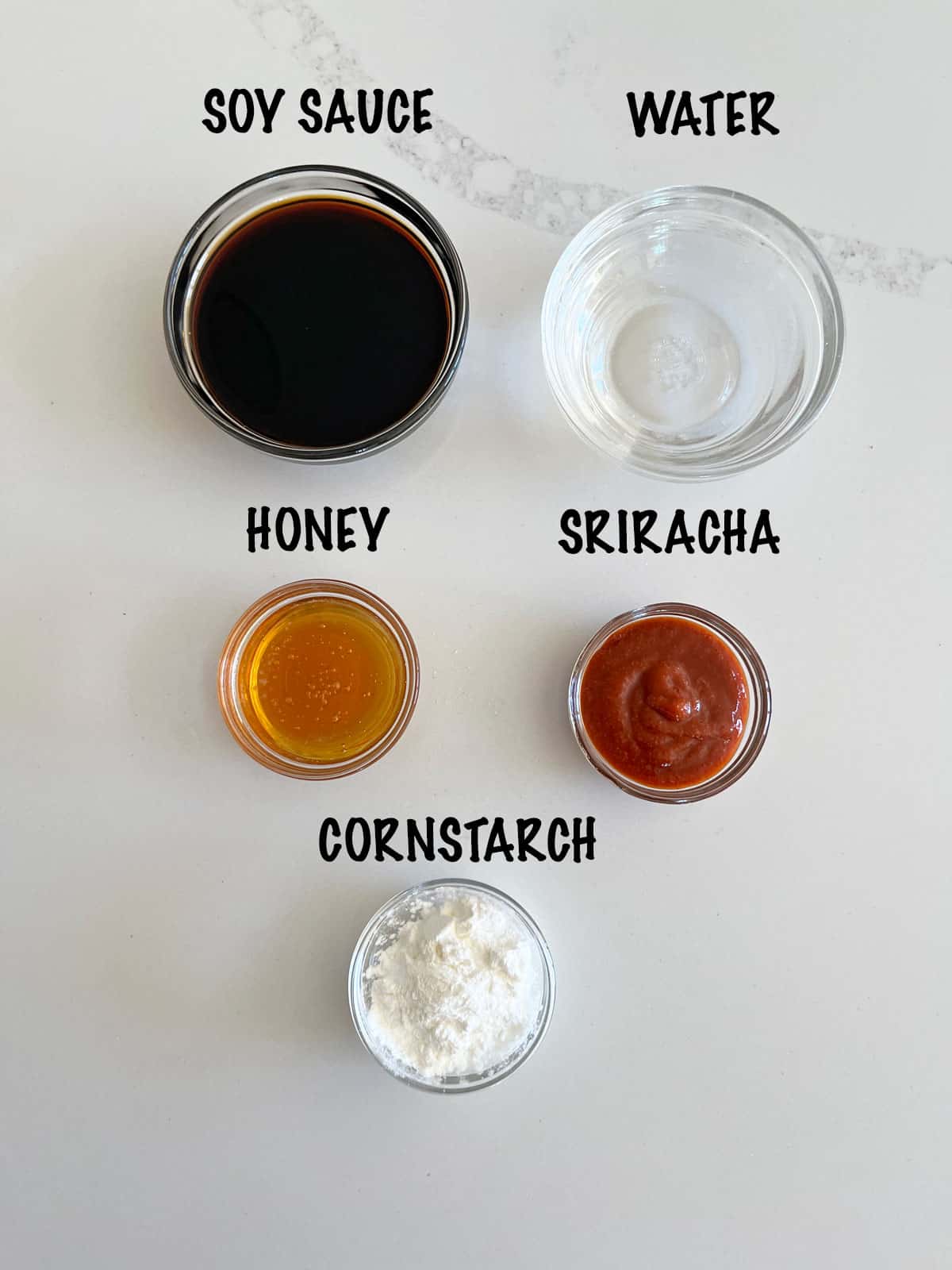
In the stir fry, I use avocado oil for cooking, sturdy vegetables (broccoli, peppers, and snap peas), aromatics (red onions, garlic, and ginger), and raw shrimp (peeled and deveined).
To finish the dish, toasted sesame oil, which adds amazing flavor (so please use it), and sesame seeds, which are used mostly as garnish and can be omitted. See the recipe card for exact measurements.
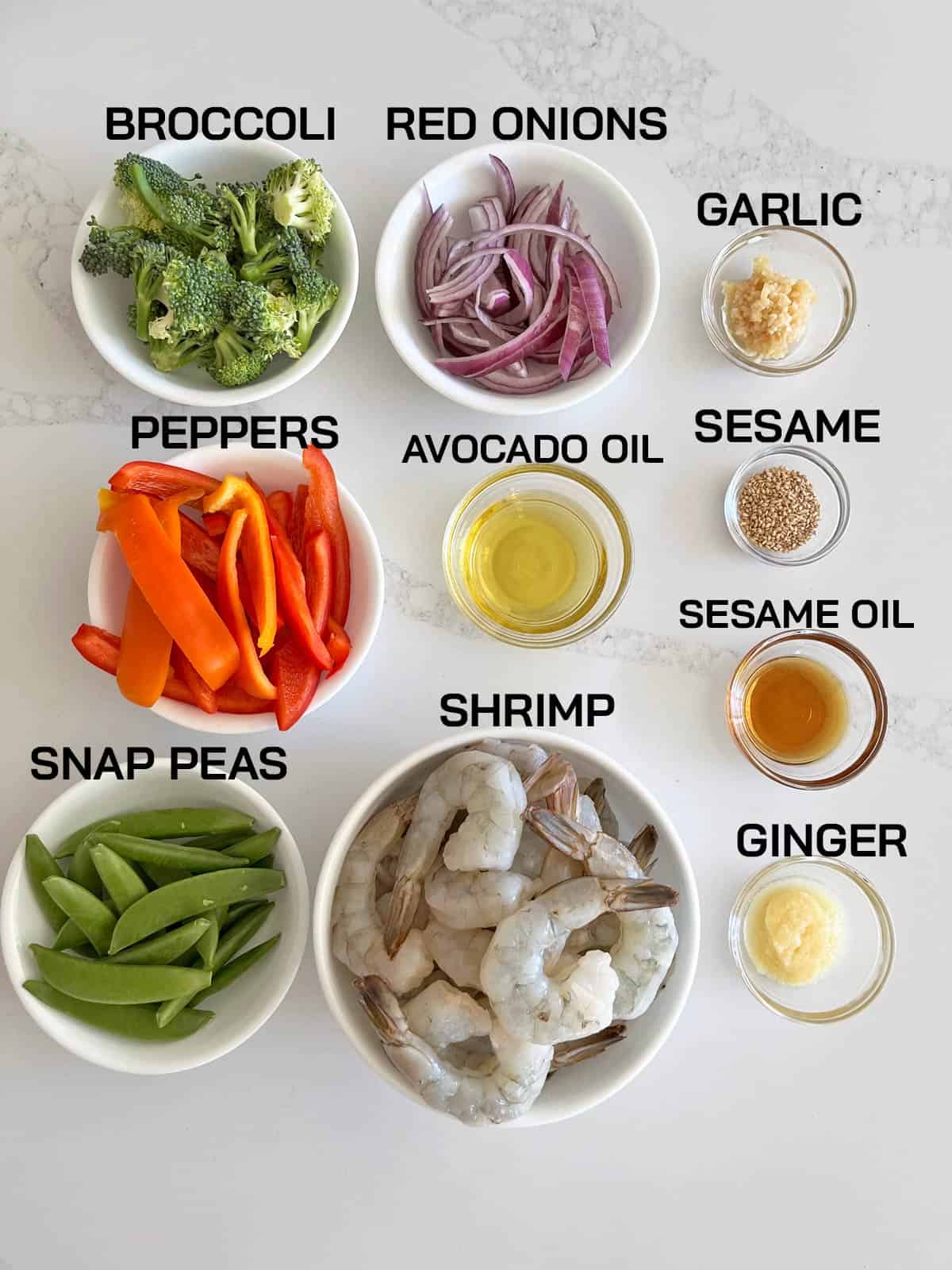
Variations
You can use about one pound of any sturdy vegetable. Good options include green beans, cauliflower florets, sliced carrots, and asparagus. The stir fry shown below was made with baby carrots and snow peas.
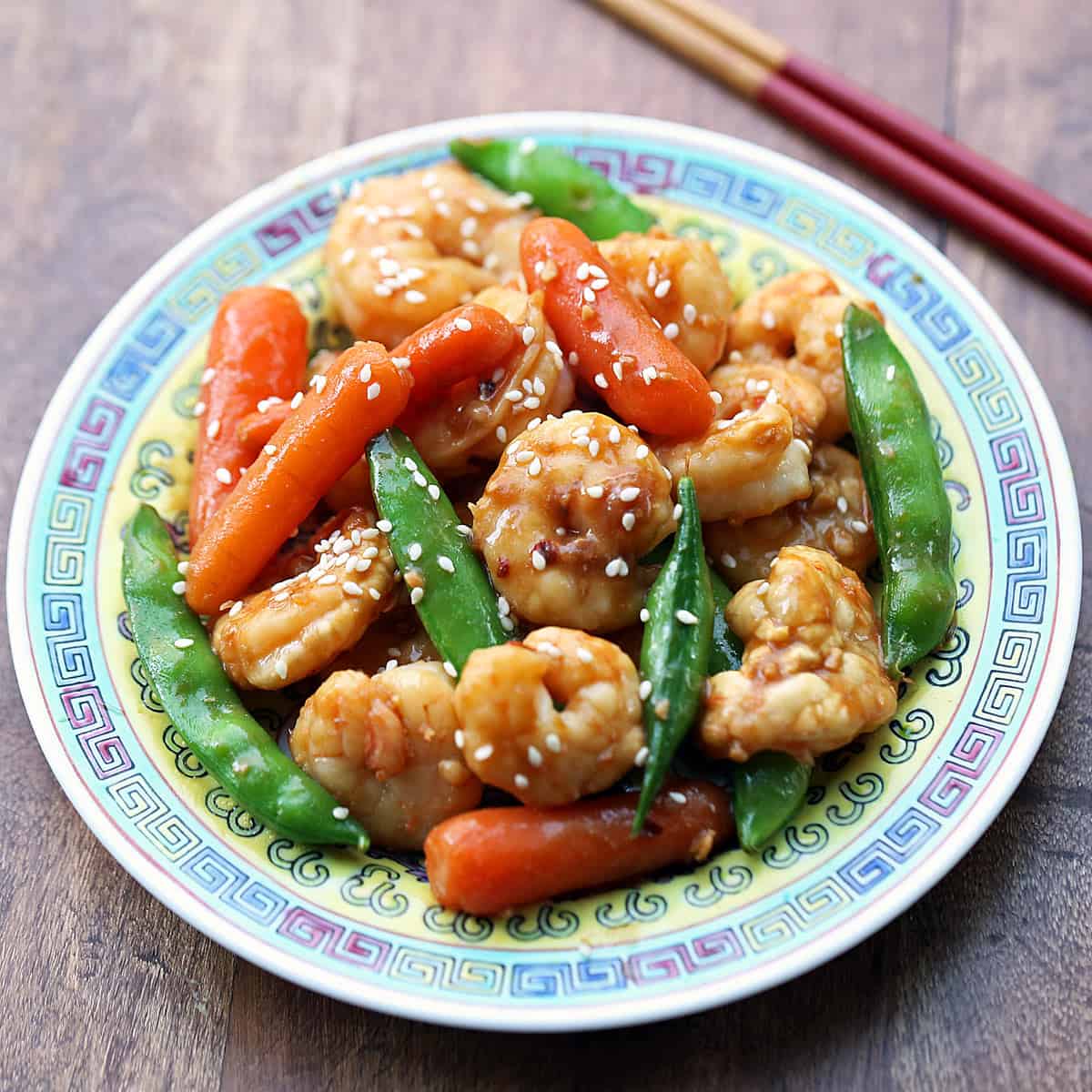
Vegetables that are not suitable for stir frying include tomatoes (they are too soft and watery), winter squashes (which are far better roasted), and dark, leafy greens (which wilt and become soggy when stir-fried).
Instructions
The detailed instructions and step-by-step photos are included in the recipe card. Here's a quick overview.
Mix the sauce and set it aside. Cook the shrimp in avocado oil until they are no longer raw, about 5 minutes. Remove to a plate and set aside.
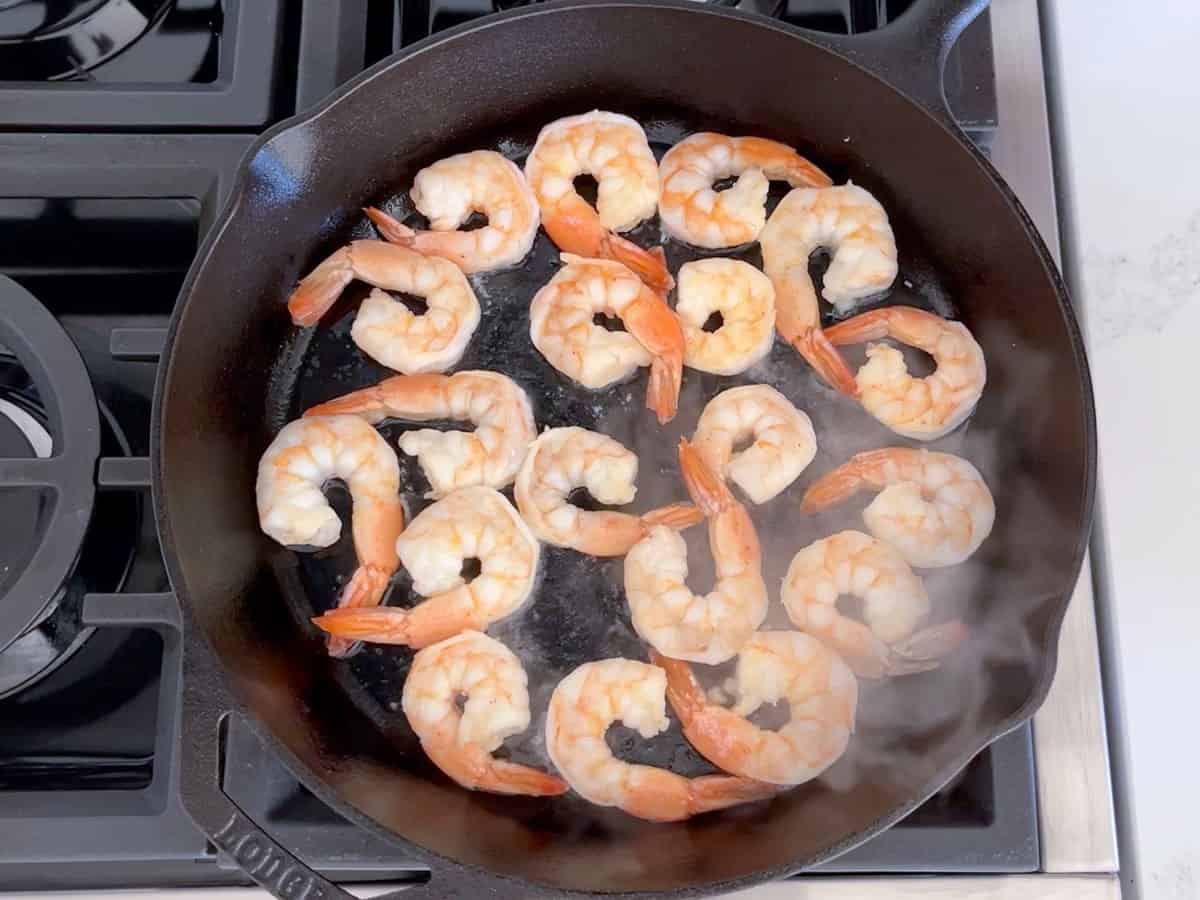
Cook the veggies until tender-crisp, about 3 minutes. Add the garlic and ginger and cook, stirring, for 30 seconds.

Reduce the heat to medium. Add the shrimp back to the skillet alongside the sauce. Continue cooking for an additional 2 minutes. Drizzle the dish with sesame oil and sprinkle it with sesame seeds, then serve.
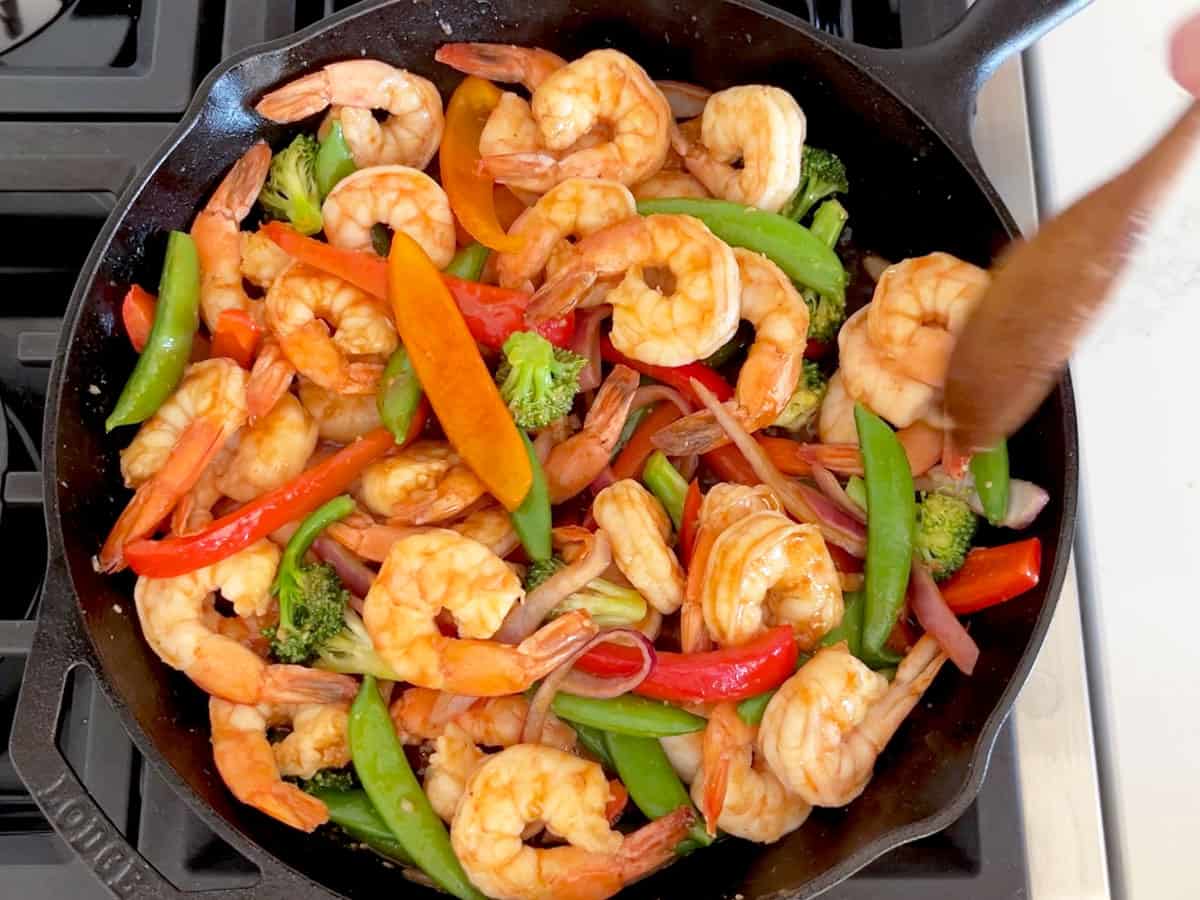
Delicious! I used some veggies that I already had (zucchini, carrots) and added broccoli, but the sauce was delicious! Although I'm 63, I'd never made something like this before. We really loved it.
Glenda
Read more comments
Recipe Tips
- While you want the shrimp to be fully cooked, you don't want them overcooked, as they will become tough and gummy. So, during the first stage of cooking, cook them just until they are opaque, then proceed with the rest of the recipe. They will cook some more after you add them back to the skillet.
- Medium shrimp (51-60 pieces per pound) work well in stir fry recipes because they are bite-sized and easy to eat. However, if you only have large shrimp (31-40 pieces per pound), that's fine too, and that's the size I used when photographing this recipe.
- Sometimes, I make this recipe with 16 ounces of frozen stir fry veggies. Fresh veggies taste better and are crisper, but frozen is convenient and works, too.
Recipe FAQs
You can use a sugar-free honey substitute to reduce the carb count per serving from 16 to 12 grams.
If making the recipe as written, you should use raw shrimp. If you'd like to use pre-cooked shrimp, skip step two in the recipe card. You'll add the cooked shrimp with the sauce after you've cooked the veggies. Please keep in mind that the shrimp will likely become slightly overcooked.
The tails can be on or off. Tail-on shrimp are more aesthetically pleasing, but tail-off shrimp are easier to eat, especially in a stir fry.
You can keep the leftovers in an airtight container in the fridge for up to three days. Reheat them covered in the microwave at 50% power. I don't recommend freezing the leftovers.
Serving Suggestions
This stir fry is great on its own, served on a plate or in a bowl, as shown in the photo below.
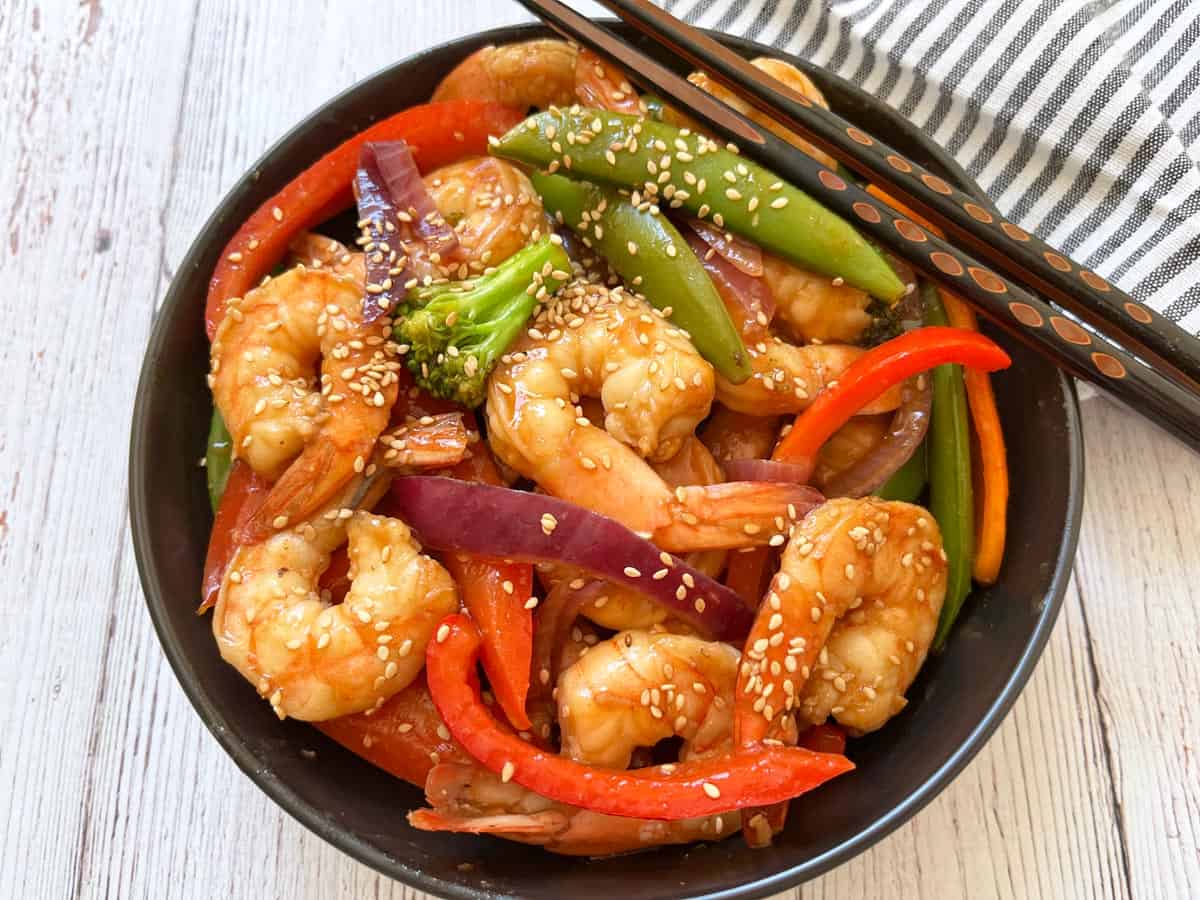
It's also delicious when served over cauliflower rice, shirataki noodles, zucchini noodles, hearts of palm pasta, sauteed spinach, or baked spaghetti squash (as shown in the photo below). Sometimes, I spoon it on a bed of raw baby spinach leaves. The hot stir fry wilts the spinach just enough to cook it perfectly.
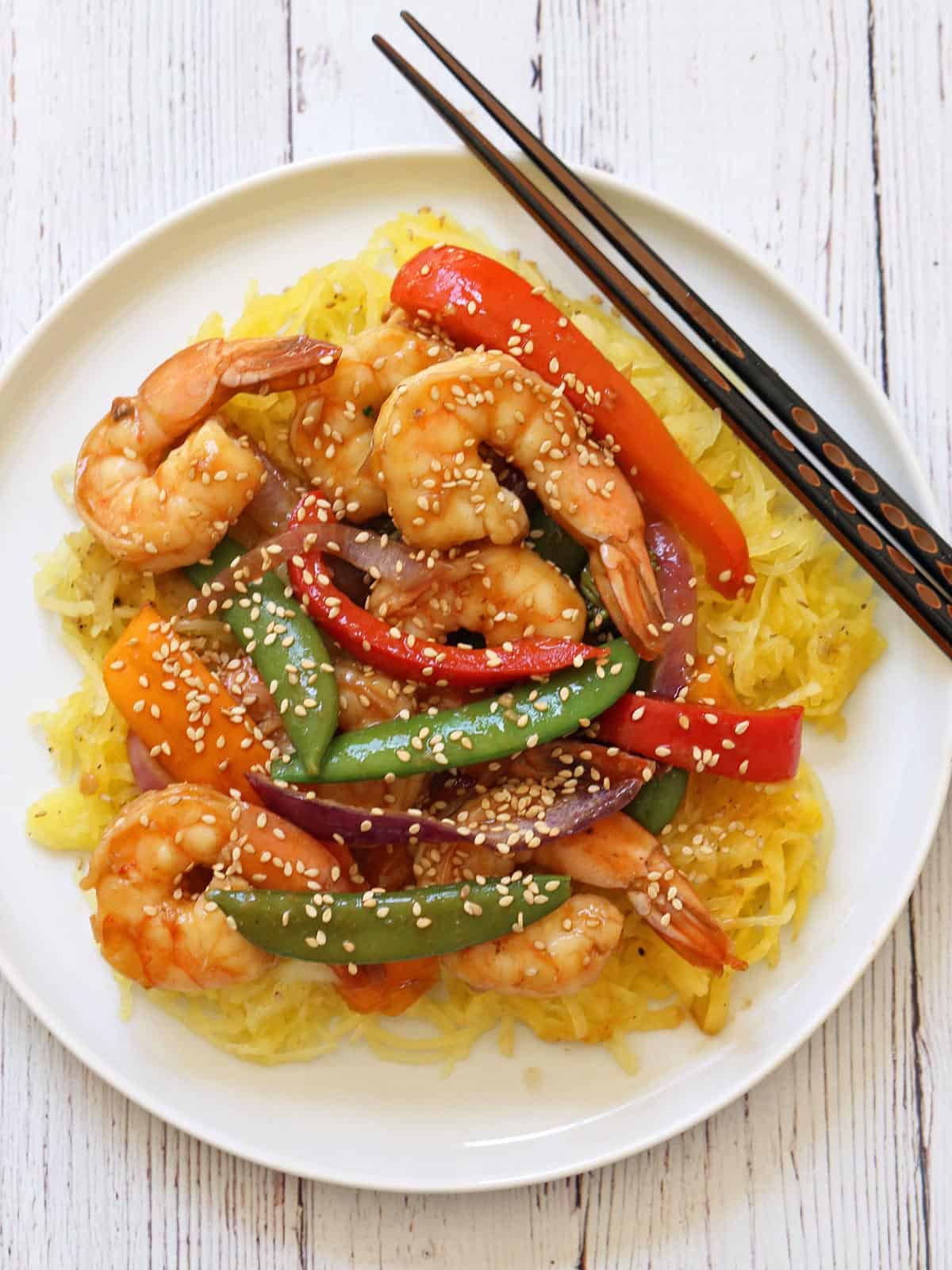
Recipe Card
Shrimp Stir Fry with Honey Sriracha Sauce
Video
Ingredients
Sauce:
- ⅓ cup reduced-sodium soy sauce
- ¼ cup water
- 1 tablespoon sriracha sauce
- 1 tablespoon honey
- 1 tablespoon cornstarch
Stir fry:
- 1 pound raw shrimp - peeled and deveined
- 2 tablespoons avocado oil - divided
- 1 cup broccoli florets - 80 grams; use small florets
- 1 cup bell peppers - sliced; 150 grams
- ½ cup sugar snap peas - 100 grams
- ½ cup red onions - sliced; 80 grams
- 1 tablespoon garlic - minced
- 1 tablespoon ginger root - grated
To finish:
- 1 tablespoon sesame oil
- 1 teaspoon sesame seeds
Instructions
- Prepare the sauce: In a small bowl, whisk together the soy sauce, water, sriracha, honey, and cornstarch. Set aside.
- In a large skillet or wok, heat 1 tablespoon of avocado oil over medium-high heat. Add the shrimp and cook until no longer raw, for about 5 minutes. Remove the shrimp to a plate and set aside.
- Add the remaining oil to the skillet, then add the broccoli, peppers, red onions, and snap peas. Cook the veggies until tender-crisp, about 3 minutes. Add the garlic and ginger and cook, stirring, for 30 seconds.
- Reduce the heat to medium. Add the shrimp back to the skillet. Give the sauce a quick stir, then add it to the skillet. Continue to cook, stirring, until the sauce has thickened and the shrimp and vegetables are coated, about 2 more minutes.
- Off heat, drizzle the dish with sesame oil and sprinkle it with sesame seeds. Serve immediately.
Notes
- You can use about one pound of any sturdy vegetable, including green beans, sliced carrots, and asparagus.
- While you want the shrimp fully cooked, you don't want them overcooked, or they'll be tough and gummy. So, during the first stage of cooking, cook them just until they are opaque, then proceed with the rest of the recipe. They will cook some more after you add them back to the skillet.
- You can use a sugar-free honey substitute to reduce the carbs per serving from 16 to 12 grams.
- Sometimes, I make this recipe with 16 ounces of frozen stir fry veggies. Fresh veggies taste better and are crisper, but frozen is convenient and works, too.
- You can keep the leftovers in an airtight container in the fridge for up to three days. Reheat them covered in the microwave at 50% power. I don't recommend freezing the leftovers.
Nutrition per Serving
Save this Recipe!
We will also add you to our weekly newsletter. Unsubscribe anytime. See healthyrecipesblogs.com/privacy/ to learn how we use your email.
Disclaimers
Most recipes are low-carb and gluten-free, but some are not. Recommended and linked products are not guaranteed to be gluten-free. Nutrition info is approximate. Please verify it independently. The carb count excludes non-nutritive sweeteners. Please read these Terms of Use before using any of my recipes.

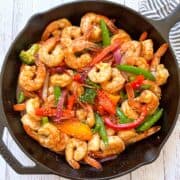

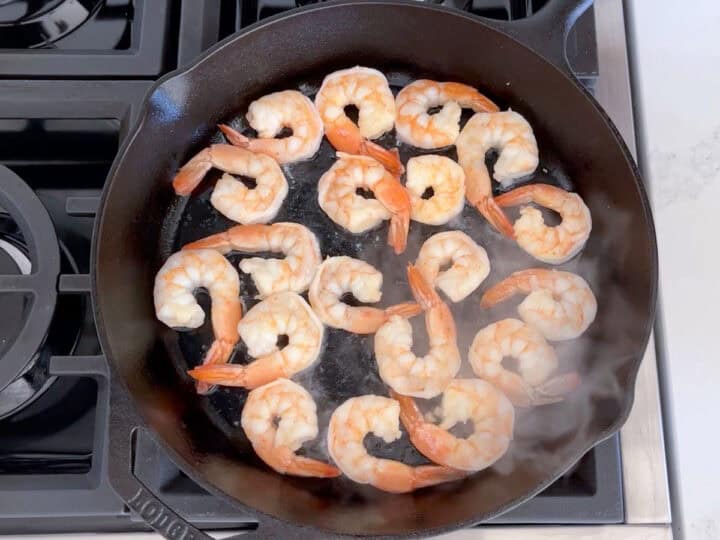
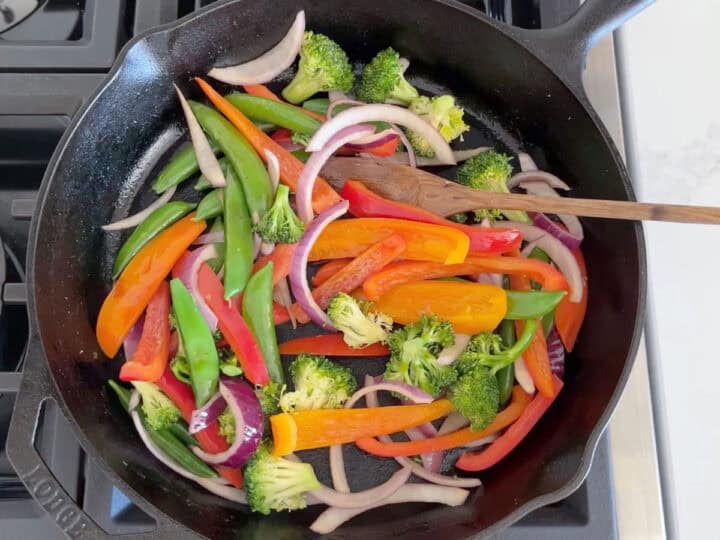
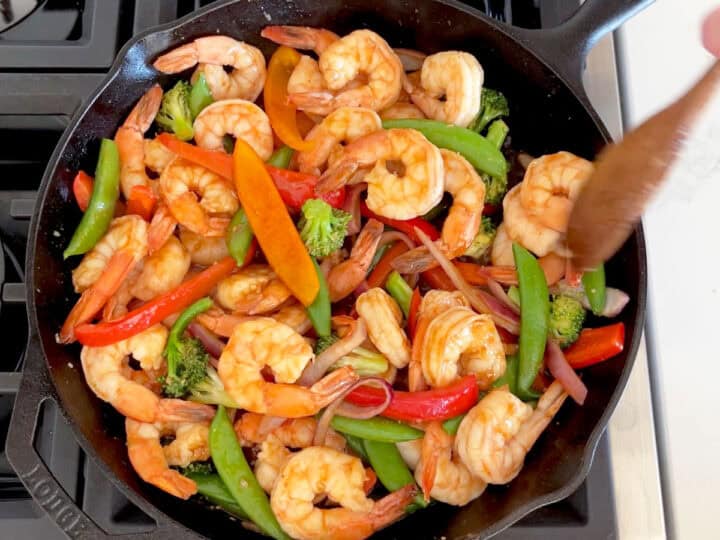
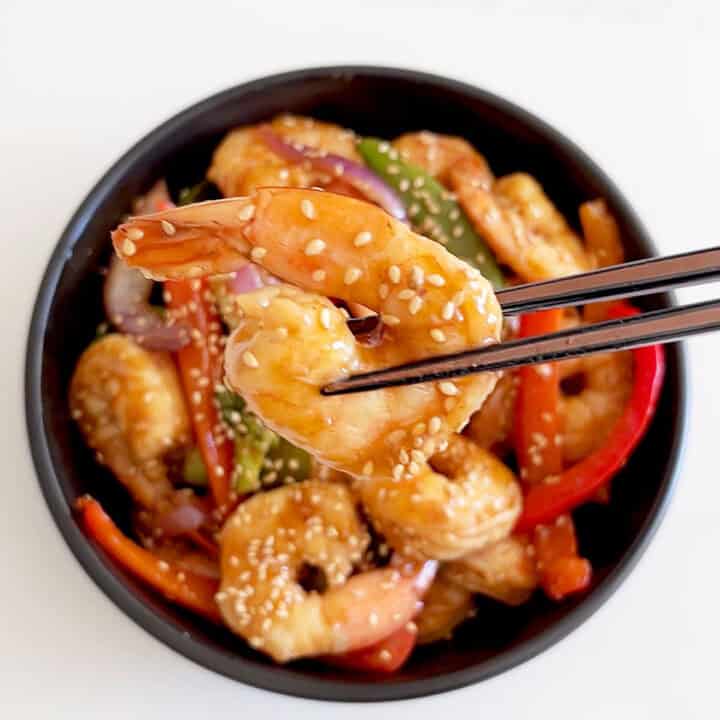

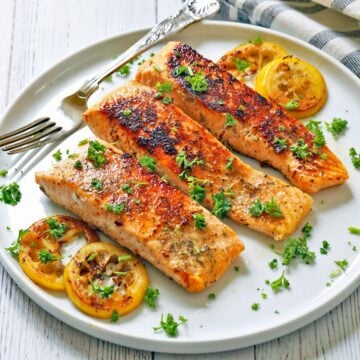
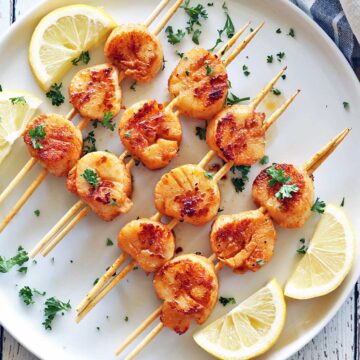

Paul says
This was easy and delicious, thanks!
Vered DeLeeuw says
Glad you liked this stir-fry, Paul! Thank you very much for the review.
Teresa Allgood says
WOW! What a great meal. It came together quickly, just as the recipe indicated. I substituted maple syrup for the honey, but otherwise followed the recipe. I needed an alternative to shrimp for one person, so I doubled the sauce recipe and used it with chicken. I only wish I had included even more veggies.
Vered DeLeeuw says
I'm so glad you enjoyed this stir-fry, Teresa! Thank you very much for the review.
Tee Clay says
Super quick and easy. Oh, and did I mention DELICIOUS
Vered DeLeeuw says
Glad you liked it! Thank you very much for the review.
Julia says
I made this recipe almost exactly but added twice as many veggies including fresh sliced carrots! It was amazing! With the extra veggies did even need rice! I will definitely add this to my rotation. I think I will try chicken or tofu next time.
Vered DeLeeuw says
I'm so glad this was a success, Julia! The extra veggies are a great idea, and this will definitely work with chicken or tofu (here's a chicken stir fry recipe I like).
Aimee says
Made this tonight, it was yummy, as is. I used fresh onion, broccoli and bell pepper for my veggies and it was perfect. Ate it over rice.
Vered DeLeeuw says
Your dinner sounds amazing, Aimee! I'm glad you enjoyed this recipe.
nancy says
Trying to eat light and love stir fry. This was amazing! Actually did use a frozen stir fry veggie mix and it was delicious!!
Vered DeLeeuw says
Wonderful, Nancy! I'm so glad you enjoyed this stir-fry. Thank you for the review.